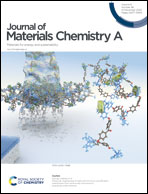3D high-density MXene@MnO2 microflowers for advanced aqueous zinc-ion batteries†
Abstract
Although manganese dioxide (MnO2) holds great promise as a cathode material for aqueous Zn-ion batteries (ZIBs), its practical application is still impeded by its low tapping density, sluggish electron transfer and rapid capacity fading during cycling. Herein, a novel 3D high-density MXene–MnO2 composite cathode material has been developed via a gas-phase spray drying strategy in which MnO2 nanoparticles are encapsulated in the crumpled and rippled MXene nanosheets, effectively constructing a robust and conductive 3D microflower-like architecture that is beneficial for rapid ion/electron transfer and high structural stability. These 3D MXene@MnO2 microflowers were used as a ZIB cathode and exhibited a large reversible specific capacity (∼301.2 mA h g−1), remarkable rate capability and outstanding cycling stability over 2000 cycles. When the mass loading was increased to 8.0 mg cm2, a high specific capacity of ∼287.6 mA h g−1 with satisfactory rate and cycling performances was still achieved in the corresponding aqueous ZIB. Furthermore, the phase evolution and electrochemical mechanism during the charge/discharge process were elucidated in depth using an in situ Raman investigation. Based on this, a flexible aqueous ZIB was assembled as a proof of concept and achieved reliable electrochemical behavior under various deformation states, revealing its potential for application in portable/wearable electronics.



 Please wait while we load your content...
Please wait while we load your content...